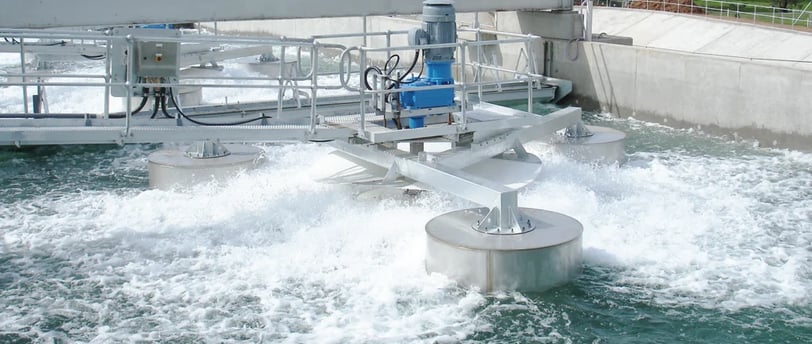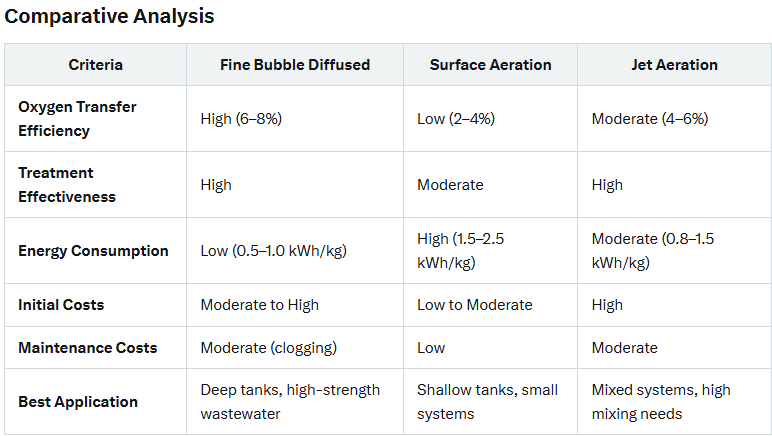Comparing Performance and Efficiency of Three Wastewater Aeration Technologies
Wastewater aeration is a critical process in treating sewage and industrial wastewater, ensuring that organic matter is broken down effectively by providing oxygen to microorganisms. With advancements in technology, various aeration systems have emerged, each with distinct performance and efficiency profiles. This blog post compares three common wastewater aeration technologies: Fine Bubble Diffused Aeration, Surface Aeration, and Jet Aeration. We’ll evaluate their performance (oxygen transfer efficiency and treatment effectiveness) and efficiency (energy consumption and operational costs) to help wastewater treatment facilities make informed decisions.
WASTEWATER
5/22/20253 min read


1. Fine Bubble Diffused Aeration
Overview: Fine bubble diffused aeration involves pumping air through diffusers at the bottom of aeration tanks, releasing small bubbles (1–2 mm in diameter) that maximize oxygen transfer to the water. These systems are widely used in municipal and industrial wastewater treatment plants.
Performance:
Oxygen Transfer Efficiency (OTE): Fine bubble systems excel in oxygen transfer, typically achieving OTEs of 6–8% per meter of water depth. The small bubble size increases surface area, enhancing oxygen dissolution.
Treatment Effectiveness: Highly effective for biological oxygen demand (BOD) and chemical oxygen demand (COD) removal, supporting robust microbial activity. Suitable for high-strength wastewater.
Efficiency:
Energy Consumption: Energy-efficient due to high OTE, requiring 0.5–1.0 kWh/kg of BOD removed. However, energy use depends on blower efficiency and system maintenance.
Operational Costs: Moderate initial costs for diffusers and blowers, with ongoing maintenance costs for cleaning or replacing clogged diffusers. Energy savings often offset these costs over time.
Pros:
High OTE reduces energy demands.
Versatile for various tank sizes and wastewater types.
Consistent performance in deep tanks.
Cons:
Diffusers can clog, requiring regular maintenance.
High upfront costs for installation.
2. Surface Aeration
Surface aerators, such as floating or fixed mechanical aerators, agitate the water surface to mix oxygen from the atmosphere into the wastewater. Common designs include low-speed turbines and high-speed propellers.
Performance:
Oxygen Transfer Efficiency: Lower OTE compared to fine bubble systems, typically 2–4% per meter of water depth. Oxygen transfer is limited by the surface area exposed to air.
Treatment Effectiveness: Effective for BOD and COD reduction in shallow tanks (less than 4 meters). Less efficient for high-strength or deep wastewater applications.
Efficiency:
Energy Consumption: Higher energy use, ranging from 1.5–2.5 kWh/kg of BOD removed, due to lower OTE and reliance on mechanical agitation.
Operational Costs: Lower initial costs compared to diffused systems, but higher energy costs can accumulate. Maintenance is simpler, focusing on motor and impeller upkeep.
Pros:
Simple design with low maintenance needs.
Effective in shallow or smaller systems.
Less prone to clogging.
Cons:
Lower OTE increases energy costs.
Limited scalability for large or deep tanks.
3. Jet Aeration
Jet aeration combines diffused aeration with mechanical mixing by injecting air and water through nozzles, creating high-velocity jets that enhance mixing and oxygen transfer. It’s often used in activated sludge processes.
Performance:
Oxygen Transfer Efficiency: Moderate OTE, typically 4–6% per meter of water depth, balancing the benefits of diffused and mechanical systems.
Treatment Effectiveness: Highly effective for BOD and COD removal, especially in systems requiring intense mixing. Suitable for both municipal and industrial applications.
Efficiency:
Energy Consumption: Moderate, ranging from 0.8–1.5 kWh/kg of BOD removed. Energy use is higher than fine bubble systems but lower than surface aerators.
Operational Costs: Higher initial costs due to complex equipment (pumps, nozzles, and blowers). Maintenance costs are moderate, with occasional nozzle cleaning required.
Pros:
Excellent mixing reduces dead zones in tanks.
Versatile for varying wastewater strengths.
Good balance of OTE and energy use.
Cons:
Higher installation costs.
Maintenance can be complex due to combined air-water systems.


Key Considerations for Selection
Facility Size and Depth:
Fine Bubble: Ideal for deep tanks (>4 meters) and large-scale municipal plants due to high OTE.
Surface Aeration: Best for smaller, shallow systems where simplicity and low upfront costs are priorities.
Jet Aeration: Suited for medium to large systems requiring strong mixing and moderate OTE.
Energy Budget:
Fine bubble systems are the most energy-efficient, making them cost-effective for long-term operations.
Surface aerators have higher energy costs, better suited for budget-constrained facilities with low initial investment.
Jet aeration offers a middle ground, balancing energy use and performance.
Wastewater Characteristics:
High-strength wastewater benefits from fine bubble or jet aeration due to their superior treatment capabilities.
Surface aeration is sufficient for low to moderate organic loads.
Maintenance Capacity:
Surface aerators require the least maintenance, ideal for facilities with limited technical resources.
Fine bubble and jet systems need regular upkeep to prevent clogging or equipment wear.
Choosing the right wastewater aeration technology depends on a facility’s specific needs, budget, and operational constraints. Fine Bubble Diffused Aeration is the top choice for energy efficiency and high-performance treatment in large or deep systems, though it requires maintenance to prevent clogging. Surface Aeration is a cost-effective, low-maintenance option for smaller or shallow systems but lags in energy efficiency. Jet Aeration strikes a balance, offering robust mixing and moderate efficiency for versatile applications.
By evaluating tank size, wastewater strength, energy costs, and maintenance capacity, treatment facilities can select the technology that optimizes performance and efficiency. For tailored recommendations, facilities should conduct site-specific pilot testing and consult with aeration system providers.
